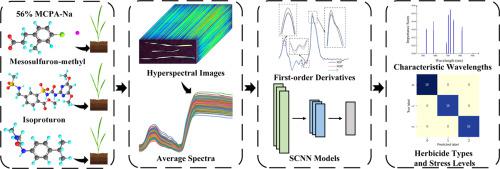Journal of Hazardous Materials ( IF 13.6 ) Pub Date : 2021-07-22 , DOI: 10.1016/j.jhazmat.2021.126706 Hangjian Chu 1 , Chu Zhang 2 , Mengcen Wang 3 , Mostafa Gouda 4 , Xinhua Wei 5 , Yong He 1 , Yufei Liu 1

|
The toxicity impacts of herbicides on crop, animals, and human are big problems global wide. The rapid and non-invasive ways for assessing herbicide-responsible effects on crop growth regarding types and levels still remain unexplored. In this study, visible/near infrared hyperspectral imaging (Vis/NIR HSI) coupled with SCNN was used to reveal the different characteristics in the spectral reflectance of 2 varieties of wheat seedling leaves that were subjected to 4 stress levels of 3 herbicide types during 4 stress durations and make early herbicide stress prediction. The first-order derivative results showed the spectral reflectance exhibited obvious differences at 518–531 nm, 637–675 nm and the red-edge. A SCNN model with attention mechanism (SCNN-ATT) was proposed for herbicide type and level classification of different stress durations. Further, a SCNN-based feature selection model (SCNN-FS) was proposed to screen out the characteristic wavelengths. The proposed methods achieved 96% accuracy of herbicide type classification and around 80% accuracy of stress level classification for both wheat varieties after 48 h. Overall, this study illustrated the potential of using Vis/NIR HSI to rapidly distinguish different herbicide types and serial levels in wheat at an early stage, which held great value for developing on-line herbicide stress recognizing methods in the field.
中文翻译:

浅层卷积神经网络 (SCNN) 的高光谱成像预测小麦品种的早期除草剂胁迫
除草剂对作物、动物和人类的毒性影响是全球范围内的大问题。评估除草剂对作物生长的类型和水平的影响的快速和非侵入性方法仍未得到探索。本研究采用可见/近红外高光谱成像 (Vis/NIR HSI) 结合 SCNN 揭示了 2 个品种的小麦幼苗叶片在 4胁持续时间并进行早期除草剂胁迫预测。一阶导数结果表明光谱反射率在 518-531 nm、637-675 nm 和红边处表现出明显的差异。针对不同胁迫持续时间的除草剂类型和级别分类,提出了具有注意机制的 SCNN 模型 (SCNN-ATT)。更远,提出了基于 SCNN 的特征选择模型 (SCNN-FS) 来筛选特征波长。所提出的方法在 48 小时后对两种小麦品种的除草剂类型分类准确率达到 96%,胁迫水平分类准确率约为 80%。总体而言,这项研究说明了使用 Vis/NIR HSI 在早期快速区分小麦中不同除草剂类型和系列水平的潜力,这对于开发田间在线除草剂胁迫识别方法具有重要价值。



























 京公网安备 11010802027423号
京公网安备 11010802027423号